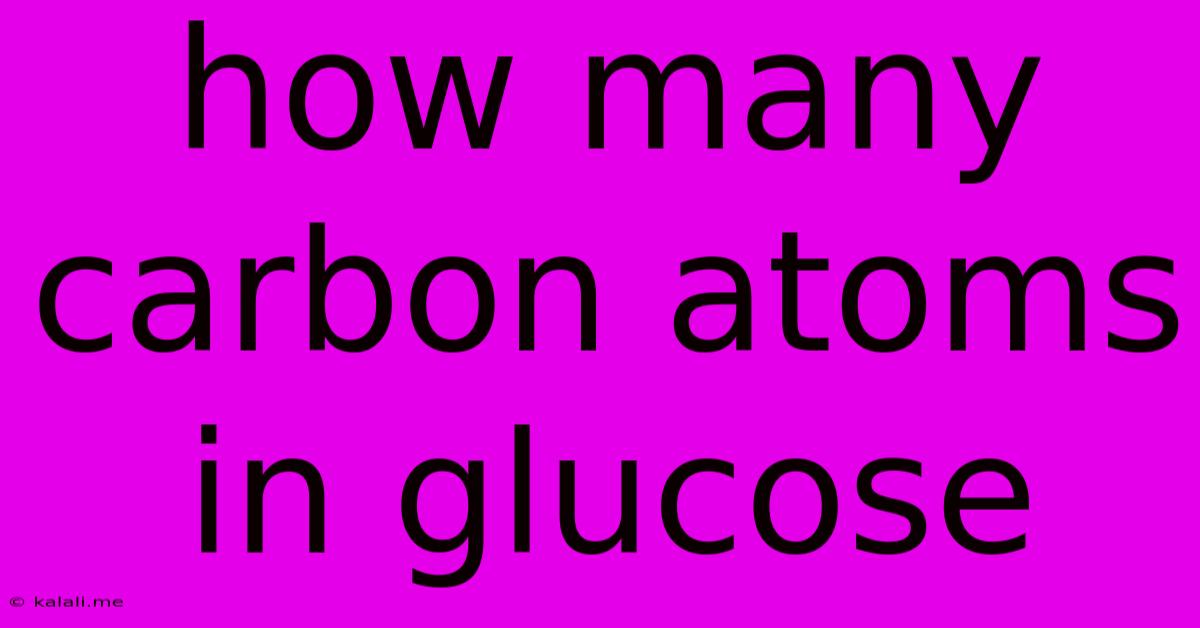How Many Carbon Atoms In Glucose
Kalali
May 09, 2025 · 3 min read

Table of Contents
How Many Carbon Atoms in Glucose? A Deep Dive into the Sugar Molecule
Glucose, a simple sugar and a key source of energy for living organisms, is a fundamental molecule in biology and chemistry. Understanding its structure, particularly the number of carbon atoms it contains, is crucial for grasping its role in metabolic processes. This article delves into the precise number of carbon atoms in a glucose molecule and explores its significance.
What is Glucose?
Glucose, also known as dextrose, is a monosaccharide, meaning it's the simplest form of carbohydrate. It's a fundamental building block for more complex carbohydrates like starch and cellulose, and it plays a vital role in cellular respiration, the process that provides energy for cells. Its chemical formula reveals its composition.
Counting the Carbon Atoms: The Chemical Formula of Glucose
The chemical formula of glucose is C₆H₁₂O₆. This formula tells us the ratio of atoms in a single molecule of glucose:
- C₆ represents six carbon atoms.
- H₁₂ represents twelve hydrogen atoms.
- O₆ represents six oxygen atoms.
Therefore, the answer to the question "How many carbon atoms in glucose?" is definitively six.
The Significance of Glucose's Carbon Backbone
The six carbon atoms form the backbone of the glucose molecule, arranged in a specific ring structure (usually a six-membered ring). This structure is crucial for glucose's function. The arrangement of these carbon atoms, along with the attached hydrogen and oxygen atoms, determines its chemical properties and interactions with other molecules within the body. For example, the hydroxyl groups (-OH) attached to these carbons are essential for glucose's solubility in water and its ability to participate in various metabolic reactions.
Glucose Isomers and Their Carbon Structure
It's important to note that glucose exists in several isomeric forms. Isomers are molecules with the same chemical formula but different structural arrangements. While all glucose isomers have six carbon atoms, the arrangement of these atoms and the attached functional groups differ, leading to variations in their properties. Common isomers include alpha-D-glucose and beta-D-glucose, differing subtly in the orientation of a hydroxyl group. These differences, while seemingly small, significantly impact their reactivity and biological roles. For example, the difference between alpha and beta glucose is critical in the structure and digestibility of starch and cellulose.
Glucose's Role in Metabolism
The six-carbon structure of glucose is central to its role in cellular respiration. Through a series of complex enzymatic reactions, glucose is broken down, releasing energy in the form of ATP (adenosine triphosphate). This process involves the stepwise oxidation of glucose's carbon atoms. The precise arrangement of the carbon atoms allows for this controlled breakdown, preventing a sudden and uncontrolled release of energy.
Conclusion: Understanding the Structure for Biological Function
In conclusion, glucose contains six carbon atoms, a fact that's fundamental to its structure, properties, and biological role as a primary energy source. Understanding this core aspect of glucose's molecular composition is essential for comprehending the intricate processes of metabolism and the chemistry of life. The arrangement of these six carbons and their interactions with other atoms define its reactivity and crucial function in countless biological systems.
Latest Posts
Latest Posts
-
What Is 3 8 As A Fraction
May 09, 2025
-
65 8 As A Mixed Number
May 09, 2025
-
What Is The Least Common Multiple Of 14 And 6
May 09, 2025
-
What Is 21 Cm To Inches
May 09, 2025
-
How Long Is 120 Cm In Feet
May 09, 2025
Related Post
Thank you for visiting our website which covers about How Many Carbon Atoms In Glucose . We hope the information provided has been useful to you. Feel free to contact us if you have any questions or need further assistance. See you next time and don't miss to bookmark.